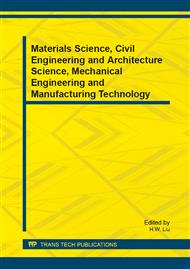[1]
C. L. Glickman and J. Dixon, Teaching algebra in a situated context through reform computer assisted instruction, Research and Teaching in Developmental Education, vol. 18, pp.57-84, (2002).
Google Scholar
[2]
K. E. Shubbar, Effectiveness of using computer-assisted instruction in teaching the shapes of atomic orbitals, Science Education International, vol. 14, pp.36-39, (2003).
Google Scholar
[3]
D. K. Davies, S. E. Stock, and M. L. Wehmeyer, Enhancing independent time-management skills of individuals with mental retardation using a palmtop personal computer, Mental Retardation, vol. 40, pp.358-365, (2002).
DOI: 10.1352/0047-6765(2002)040<0358:eitmso>2.0.co;2
Google Scholar
[4]
J. Bache and G. Derwent, Access to computer-based leisure for individuals with profound disabilities, NeuroRehabilitation, vol. 23, pp.343-350, (2008).
DOI: 10.3233/nre-2008-23408
Google Scholar
[5]
H. Ritchie and P. Blanck, The promise of the Internet for disability: a study of on‐line services and web site accessibility at Centers for Independent Living, Behavioral Sciences & the Law, vol. 21, pp.5-26, (2003).
DOI: 10.1002/bsl.520
Google Scholar
[6]
C. T. Shih, C. H. Shih, and C. H. Luo, Evaluation of a dynamic pointing assistive program in cursor pointing efficiency for people with disabilities, Technology and Disability, vol. 23, pp.215-222, (2011).
DOI: 10.3233/tad-2011-0328
Google Scholar
[7]
S. -C. Hsu and T. -C. Wang, Solving multi-criteria decision making with incomplete linguistic preference relations, Expert Systems with Applications, vol. 38, pp.10882-10888, (2011).
DOI: 10.1016/j.eswa.2011.02.123
Google Scholar
[8]
Z. Xu, Incomplete linguistic preference relations and their fusion, Information Fusion, vol. 7, pp.331-337, (2006).
DOI: 10.1016/j.inffus.2005.01.003
Google Scholar
[9]
Z. Xu, A method for multiple attribute decision making with incomplete weight information in linguistic setting, Knowledge-Based Systems, vol. 20, pp.719-725, (2007).
DOI: 10.1016/j.knosys.2006.10.002
Google Scholar
[10]
T. -H. Chang, S. -C. Hsu, T. -C. Wang, and C. -Y. Wu, Measuring the success possibility of implementing ERP by utilizing the Incomplete Linguistic Preference Relations, Applied Soft Computing, vol. 12, pp.1582-1591, (2012).
DOI: 10.1016/j.asoc.2011.12.008
Google Scholar


